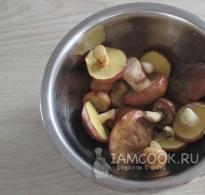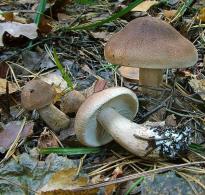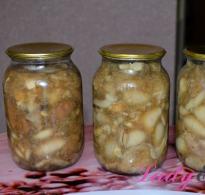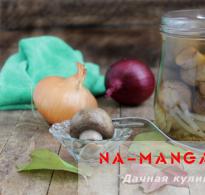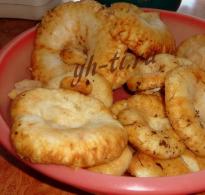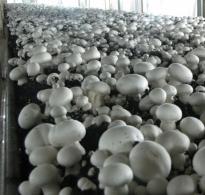Row mushrooms - photo and description of what rows look like
Fans of row mushrooms assure that this mushroom can be consumed in any form - fresh and salty, and its taste is quite decent. It seems to me that rowan mushrooms, the description of which we will give below, have some kind of non-mushroom, non-spirited smell, but their flesh is crispy, and they look elegant. You just need to be able to distinguish numerous species from several obviously poisonous ones and know what edible rows look like.
Ryadovka mushrooms - photo and description of edible varieties
The rows most collected by the people, as a rule, have a pronounced color that distinguishes them from other "toadstools".
Ryadovka Red - a description of the type of mushroom
The red row (Tricholoma rutilans Sing.) is distinguished by a bright red, almost burgundy, sometimes crimson cap and yellow contrasting plates. Elegant and leg - yellow, burgundy, covered with burgundy scales. The pulp is yellow, fragile, sweet. Little Red Riding Hood grows on rotten stumps, humus of leaves and needles, in colonies of 5-10 mushrooms. The growth of the fungus is 6-12 cm, the children sit in a heap, next to their parents.
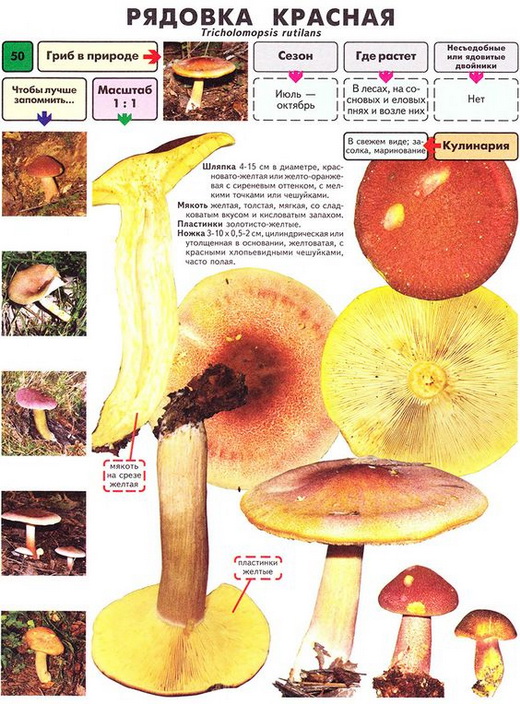
Photo: Description of the species - Red Row
Violet Ryadovka - description of the species
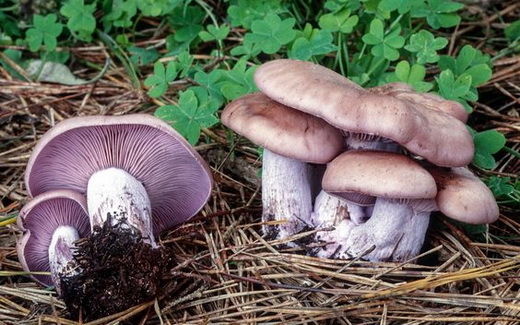
No lesser groups can be found in the forest and in parks in late autumn, the violet row (Lepista nuda Cke.) - its intense pink color of the hat gradually turns pale under the onslaught of bad weather and the first snowfall. The purple-pink leg (up to 18 cm tall) is very dense, but does not hold the mushroom well in the ground - it is enough to pick it up once, and the defeated snowdrop falls, tearing out a piece of soil. The legs are carefully trimmed, and the last fresh gift of nature before a long winter sleep is carefully carried home.
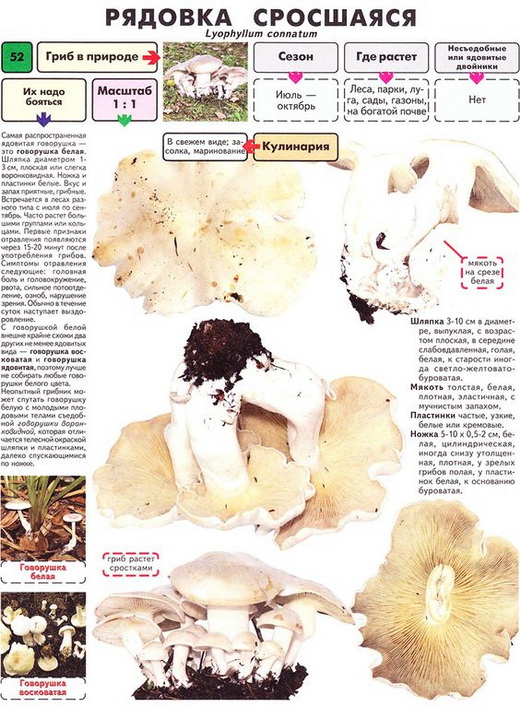
Photo: Description of the species - Violet Row
What Row Looks Like Yellow-Green
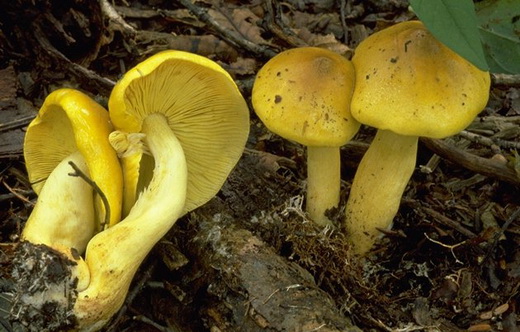
No less elegant is the greenfinch - greenish-yellow, covered with small scales, yellow-green rowing (Tricholoma flavovirens Lund.). When the edge of the mushroom is broken, bright yellow flesh is visible under the skin of the cap, but it itself is whitish. The leg is dense, yellow, with scales. Growth - 8-10 cm, bright and elegant specimens come across closer to autumn in small flocks.
The main color of the cap of this type of rowing is greenish-yellow, in the center it is yellow-brown with very small scales. The pale yellow stalk is squat and thin. In greenfinches growing in green forests, the stem is longer and even thinner. When broken, the stem splits in the longitudinal-radial direction. The flesh is white, dense, yellowish under the skin of the cap. The plates are a beautiful gray-yellow color. On the southern coast of Finland, greenfinch is found along with green mosses, it is suitable for food even in November. The species is resistant to slight frosts.
Greenfinch is a delicacy mushroom, especially in fried or stewed dishes. The mushroom has a rather dense pulp, requiring thorough stewing or roasting. Zelenushka can be preserved in several ways, but drying is especially recommended, since the taste is significantly improved with this method. Before cooking from dried greenfinches, they should be pre-soaked (for 15 minutes) in cold water, then boiled for about 5 minutes over low heat. Zelenushka is harvested by the trading network.
What does a mushroom look like - Ryadovka Pigeon
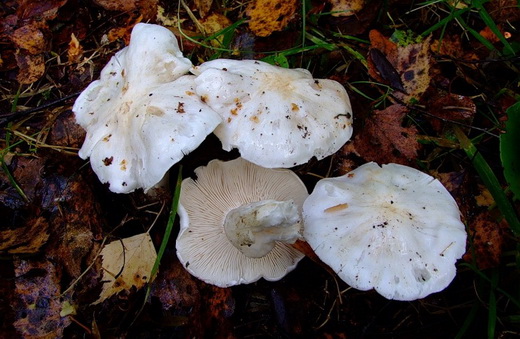
Hat (6-10 cm) silky white. During rain, the surface of the cap is sticky, the edges of the cap are wavy-curved. The flesh is white, pleasant in taste and with a powdery smell. The leg is white with a curved base. It occurs locally in the southern part of the country. Grows in forests with high humidity. Good edible mushroom.
The cap is pure white with a shiny silky surface and fibrous in the radial direction. In old mushrooms, the edge of the cap is wavy-curved and often cracked. The plates are white, frequent. The stipe tapers towards the base and is gently or steeply curved at the base. The surface of the leg is fibrous. The pulp slowly turns pink in places of a break or a cut. On the surface of the cap of old mushrooms there are sometimes blue-red or blue-green spots. The species grows locally in the southern part of the country. It occurs in deciduous and mixed forests with high humidity, in groves.
Good edible mushroom. It is used to prepare various mushroom dishes. The floury smell of the mushroom is especially clearly felt when cutting. During cooking, the flesh turns red.
Row Crowded - what does a mushroom look like
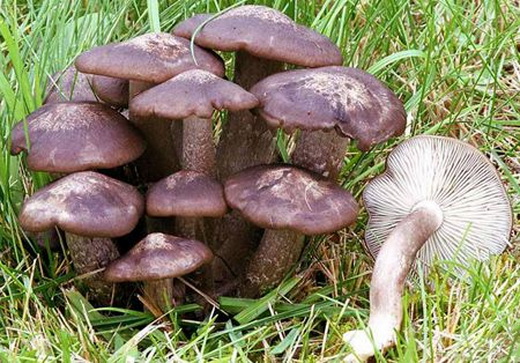
Caps (4-12 cm) gray-brown. The plates are light with a predominance of a gray tint. The legs are light. The pulp is dense, pleasant to the taste. Grows in large fused groups, “o rather rare.
Sometimes mushrooms are found in rather large dense groups with fused bases of legs. They grow on humus-rich lawns, in parks, along roadsides, etc. Quite a rare species. The upper part of the leg is covered with a white fleecy layer. In dense, fused groups, the caps and legs, as a rule, are deformed. A good edible mushroom with a variety of uses.
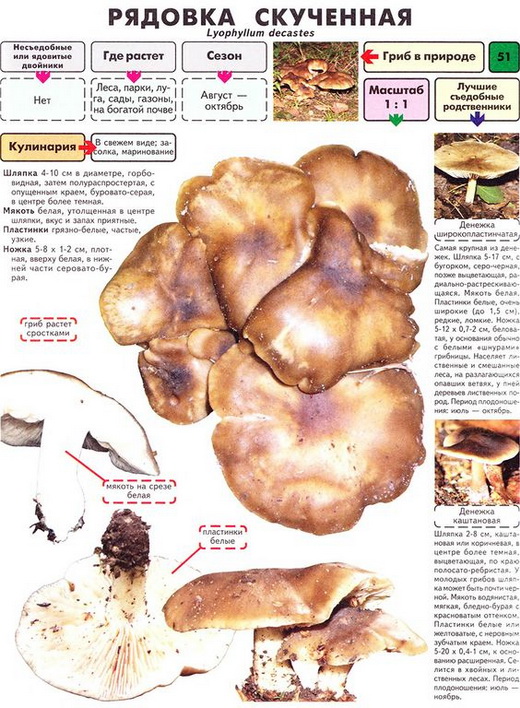
Photo: Description of the species Ryadovka Clustered
Ryadovka Merged - photo and description of the species
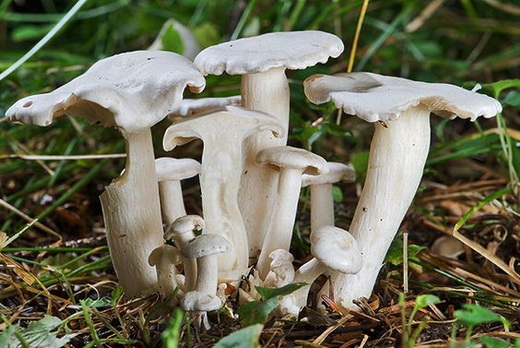
The fused rowweed (Lyophillum connatum) is found in groups on park lawns. The caps of the row of fused are white, of a chalky shade (in old mushrooms they are off-white). The pulp is light-water, tasteless, tough.
The species does not form such large fused groups as the crowded row. At most - a few specimens, fused at the bases of the legs. Recorded locally in southern and middle parts of Finland, extremely rare in northern. An edible fungus of low value, best avoided to avoid confusion with poisonous species.
Photo: Description of the species Ryadovka Merged
Ryadovka Solitary - description and photo
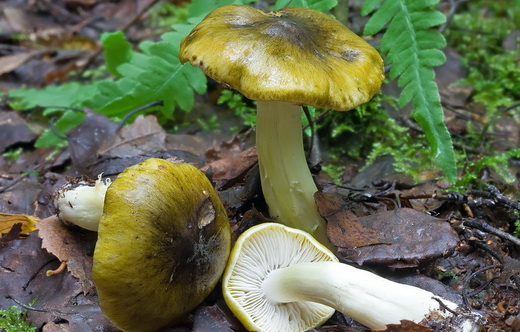
A more faded isolated row (Tricholoma sejunctum Quel.) Has an olive-black, dark green hat and white plates, branched and large. The leg is whitish, painted only below. Occurs in single specimens, but quite often. The mushroom is considered conditionally edible.
Inedible and poisonous mushrooms Ryadovki - description and photo
What the White Rows look like - description
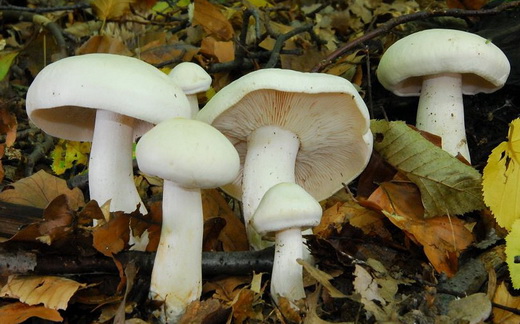
Suspiciously white, with a slightly creamy tint, the white row (Tricholoma album Fr.) is an albino among bright beauties. It is distinguished from the white fly agaric and the pale grebe by the absence of a ring on the leg and a thickening in the form of a bulb, which are inherent only in poisonous fly agaric. Very often, the white "witch circles" that appear every year in the forests and in our summer cottages are formed by this particular species.
The grayish-white surface of the fungus is always dry and dull. The middle part of the cap of old mushrooms is yellowish-brown. Plates are white. The leg is white, dense, but with age from the base becomes yellowish-brown. The flesh is white, turns pink in places of fracture and in old mushrooms.
Ryadovka white grows in large groups in dense forests, near populated areas, as well as in groves and parks. Due to the white coloring, white rowing is often mistaken for mushrooms, but light, not darkening plates, a strong smell of radish (not anise) and a pungent, burning taste distinguish white rowing from mushrooms. The mushroom is considered inedible, but not poisonous.
Ryadovka Pointed - photo and description of the species
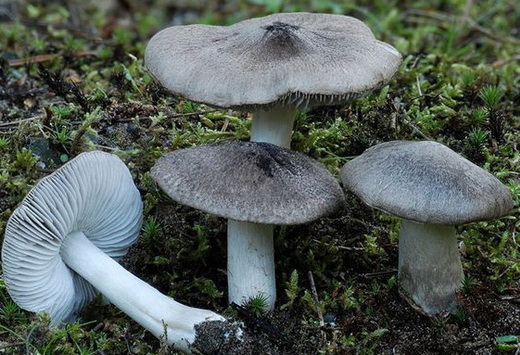
The cap of the row pointed (5-10 cm) is ash-gray in color with pointed tubercles in the center. Pulp, stem and plates are gray-white. The species is widely distributed in the southern and middle parts of the country. Row grows pointed in coniferous forests. The taste is bitter-bitter. Inedible, poisonous.
Ryadovka mushrooms, which we described above, are often eaten and the mushroom is valued as the owner of a delicate taste. Now you know what rows look like, and you can collect edible mushrooms and cook delicious dishes.

